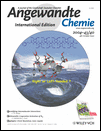Arylamine-Substituted Hexa-peri-hexabenzocoronenes: Facile Synthesis and Their Potential Applications as “Coaxial” Hole-Transport Materials†
Jishan Wu Dr.
Max-Planck-Institut für Polymerforschung, Ackermannweg 10, 55128 Mainz, Germany, Fax: (+49) 6131-379-350
Search for more papers by this authorMartin Baumgarten Dr.
Max-Planck-Institut für Polymerforschung, Ackermannweg 10, 55128 Mainz, Germany, Fax: (+49) 6131-379-350
Search for more papers by this authorMichael G. Debije Dr.
IRI, Delft University of Technology, Mekelweg 15, 2629 JB Delft, The Netherlands
Search for more papers by this authorJohn M. Warman Prof. Dr.
IRI, Delft University of Technology, Mekelweg 15, 2629 JB Delft, The Netherlands
Search for more papers by this authorKlaus Müllen Prof. Dr.
Max-Planck-Institut für Polymerforschung, Ackermannweg 10, 55128 Mainz, Germany, Fax: (+49) 6131-379-350
Search for more papers by this authorJishan Wu Dr.
Max-Planck-Institut für Polymerforschung, Ackermannweg 10, 55128 Mainz, Germany, Fax: (+49) 6131-379-350
Search for more papers by this authorMartin Baumgarten Dr.
Max-Planck-Institut für Polymerforschung, Ackermannweg 10, 55128 Mainz, Germany, Fax: (+49) 6131-379-350
Search for more papers by this authorMichael G. Debije Dr.
IRI, Delft University of Technology, Mekelweg 15, 2629 JB Delft, The Netherlands
Search for more papers by this authorJohn M. Warman Prof. Dr.
IRI, Delft University of Technology, Mekelweg 15, 2629 JB Delft, The Netherlands
Search for more papers by this authorKlaus Müllen Prof. Dr.
Max-Planck-Institut für Polymerforschung, Ackermannweg 10, 55128 Mainz, Germany, Fax: (+49) 6131-379-350
Search for more papers by this authorThis work was financially supported by the Zentrum für Multifunktionelle Werkstoffe und Miniaturisierte Funktionseinheiten (BMBF 03N 6500), the Deutsche Forschungsgemeinschaft (Schwerpunkt Organische Feldeffekttransistoren, as well as the EU project DISCELs (G5RD-CT-2000-00321) and MAC-MES (Grd2-2000-30242).
Graphical Abstract
The hole story: using a new synthetic concept the title hexa-peri-hexabenzocoronenes (HBCs) were synthesized with high atom economy. The coaxial arrangement of the HBCs and arylamines allowed a “double-cable” hole transport (see picture), that is, transport through the central core (white) and the outer shell (green).
Supporting Information
Supporting information for this article is available on the WWW under http://www.wiley-vch.de/contents/jc_2002/2004/z460174_s.pdf or from the author.
Please note: The publisher is not responsible for the content or functionality of any supporting information supplied by the authors. Any queries (other than missing content) should be directed to the corresponding author for the article.
References
- 1
- 1aC. W. Tang, S. A. VanSlyke, Appl. Phys. Lett. 1987, 51, 913–915;
- 1bR. H. Friend, R. W. Gymer, A. B. Holmes, J. H. Burroughes, R. N. Marks, C. Taliani, D. D. C. Bradley, D. A. Dos Santos, J. L. Brédas, M. Lögdlund, W. R. Salaneck, Nature 1999, 397, 121–128.
- 2
- 2aC. W. Tang, Appl. Phys. Lett. 1986, 48, 183–185;
- 2bU. Bach, D. Lupo, P. Compte, J. E. Moser, F. Weissörtel, J. Salbeck, H. Spreitzer, M. Grätzel, Nature 1998, 395, 583;
- 2cN. S. Sarififtci, L. Smilowitz, A. J. Heeger, F. Wudl, Science 1992, 258, 1474–1476.
- 3Z. Bao, J. A. Rogers, E. Katz, J. Mater. Chem. 1999, 9, 1895–1904.
- 4S. J. Zilker, ChemPhysChem 2000, 1, 72–87.
- 5M. Thelakkat, Macromol. Mater. Eng. 2002, 287, 442–461.
- 6
- 6aM. D. Watson, A. Fechtenkötter, K. Müllen, Chem. Rev. 2001, 101, 1267–1300;
- 6bA. M. van de Craats, J. M. Warman, A. Fechtenkötter, J. D. Brand, M. A. Harbison, K. Müllen, Adv. Mater. 1999, 11, 1469–1472.
10.1002/(SICI)1521-4095(199912)11:17<1469::AID-ADMA1469>3.0.CO;2-K CAS Web of Science® Google Scholar
- 7K. R. Stickley, S. C. Blackstock, J. Am. Chem. Soc. 1994, 116, 11 576–11 577.
- 8
- 8aC. Lambert, G. Nöll, Angew. Chem. 1998, 110, 2239–2242;
10.1002/(SICI)1521-3757(19980803)110:15<2239::AID-ANGE2239>3.0.CO;2-H Google ScholarAngew. Chem. Int. Ed. 1998, 37, 2107–2110;10.1002/(SICI)1521-3773(19980817)37:15<2107::AID-ANIE2107>3.0.CO;2-H CAS PubMed Web of Science® Google Scholar
- 8bC. Lambert, G. Nöll, J. Am. Chem. Soc. 1999, 121, 8434–8442;
- 8cC. Lambert, G. Nöll, Chem. Eur. J. 2002, 8, 3467–3477.
10.1002/1521-3765(20020802)8:15<3467::AID-CHEM3467>3.0.CO;2-1 CAS PubMed Web of Science® Google Scholar
- 9
- 9aJ. P. Wolfe, S. L. Buchwald, J. Org. Chem. 1997, 62, 6066–6068;
- 9bJ. F. Hartwig, M. Kawatsura, S. I. Hauck, K. H. Shaughnessy, L. M. Alcazar-Roman, J. Org. Chem. 1999, 64, 5575–5580.
- 10S. Ito, M. Wehmeier, J. D. Brand, C. Kübel, R. Epsch, J. P. Rabe, K. Müllen, Chem. Eur. J. 2000, 6, 4327–4342.
10.1002/1521-3765(20001201)6:23<4327::AID-CHEM4327>3.0.CO;2-7 CAS PubMed Web of Science® Google Scholar
- 11J. Wu, M. D. Watson, K. Müllen, Angew. Chem. 2003, 115, 5487–5491; Angew. Chem. Int. Ed. 2003, 42, 5329–5333.
- 12S. Taskahashi, Y. Kuroyama, K. Sonogashira, N. Hagihara, Synthesis 1980, 627–630.
- 13N. Miyaura, A. Suzuki, Chem. Rev. 1995, 95, 2457–2483.
- 14C. L. Nesloney, J. W. Kelly, J. Org. Chem. 1996, 61, 3127–3137.
- 15J. A. Hyatt, Org. Prep. Proced. Int. 1991, 23, 460–463.
- 162D WAXD was performed on a mechanically extruded fiber with the X-ray beam perpendicular to the fiber axis. For experimental details, see: I. Fischbach, T. Pakula, P. Minkin, A. Fechtenkötter, K. Müllen, H. W. Spiess, J. Phys. Chem. B 2002, 106, 6408–6418.
- 17An approximate 2D monoclinic unit cell a=2.17, b=1.56 nm, and χ=97° can also be determined based on the correlations of the equatorial reflections.
- 18At low temperature the intramolecular charge transfer most probably was forbidden, thus only three-line ESR spectra correlated to singly charged amines were observed.
- 19
- 19aJ. Bonvoisin, J. P. Launay, M. van der Auweraer, F. C. De Schryver J. Phys. Chem. 1994, 98, 5052–5067;
- 19bV. Coropceanu, M. Malagoli, J. M. André, J. L. Brédas, J. Am. Chem. Soc. 2002, 124, 10 519–10 530.
- 20P. G. Schouten, J. M. Warman, M. P. de Haas, J. Phys. Chem. 1993, 97, 9863–9870.
- 21
- 21aP. M. Borsenberger, L. Pautmeier, R. Richert, H. Bässler, J. Chem. Phys. 1991, 94, 8276–8281;
- 21bP. M. Borsenberger, L. Pautmeier, H. Bässler, J. Chem. Phys. 1991, 94, 5447–5454.
- 22A detailed study of the intramolecular charge transfer in the mixed-valence compounds will be presented in a separate publication.
Citing Literature
October 11, 2004
Pages 5331-5335





